Big Bend National Park is not on the way to anywhere. Situated at the southern point of the “dip” in West Texas, it is essentially a peninsula of the US with Mexico on three sides. The park is located in the heart of the harsh Chihuahuan Desert, and the park’s southern border is also the international border: the Rio Grande. There are just a few tiny towns situated on the outskirts of the very sizeable park, which is larger than the state of Rhode Island, making a visit logistically challenging. Maybe these very challenges are some of the reasons I was determined to include Big Bend on our trip through Texas. Our visit was relatively abbreviated (for us) at 6 nights, but this gave us enough time to visit each of the park’s three distinct sections for at least one day.
Big Bend: Scenic Drive to Santa Elena Canyon
The western portion of the park is accessed mainly from the Maxwell Scenic Drive which runs south and west from the main park road to the Rio Grande. The scenic drive passes through some higher elevation areas with dramatic views and some transitional areas before dropping all the way down to the lush green floodplain of the Rio Grande. One day we explored the scenic drive from top to bottom, stopping at numerous pullouts and overlooks and taking several short hikes. At the southern terminus of the scenic drive is the Santa Elena Canyon, where the slow-moving Rio Grande flows through a deep and narrow channel. The water level was too high to attempt the hike along the US side of the canyon but we enjoyed seeing the impressive natural “wall” that runs along the international border here.
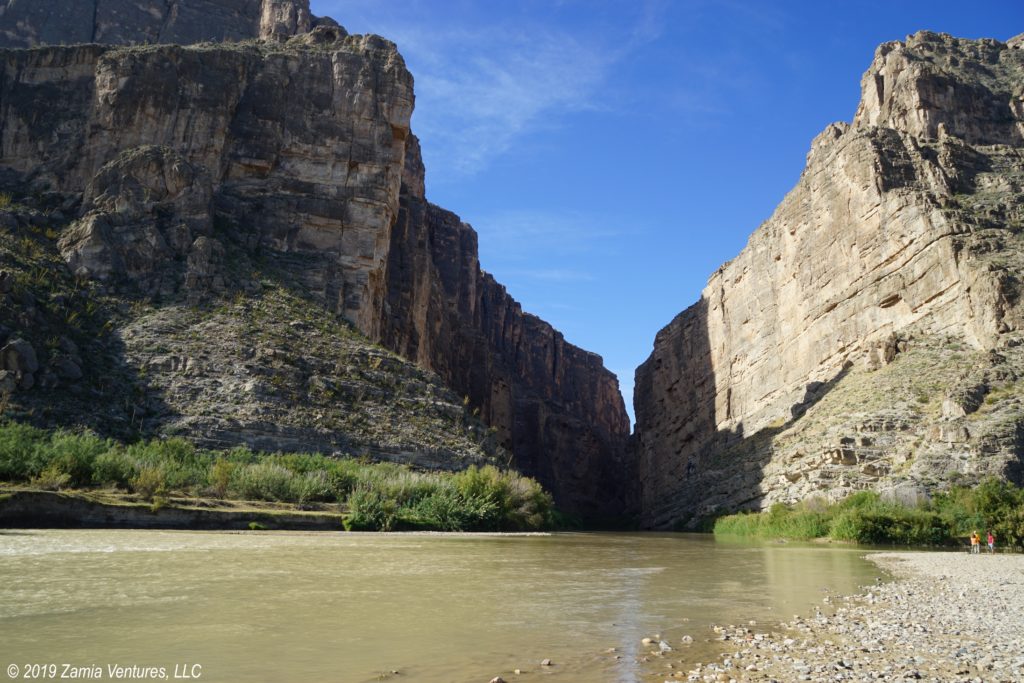
At other points along the scenic drive we took short hikes out to check out unusual geological formations like the smooth “pouroff” where all the water that collects on the large Burro Mesa drains out during the rare but violent monsoon rains. Mostly we just marveled at the rugged formations of rock jutting up from the unforgiving desert.
Big Bend: Chisos Mountains
At the center of the park sit the Chisos Mountains, a volcanic range which reaches over 8,000 feet in elevation. The mountains surround an elevated plain called the Chisos Basin which receives several more inches of water each year than the surrounding desert, and is kept at reasonable temperature by the high elevation. As a result the Chisos Basin is filled with a dense forest of leafy trees and shrubs that coexist peacefully with typical desert plants like cacti and yucca. This oasis is home to a large number of animals, including a permanent population of black bears and mountain lions.
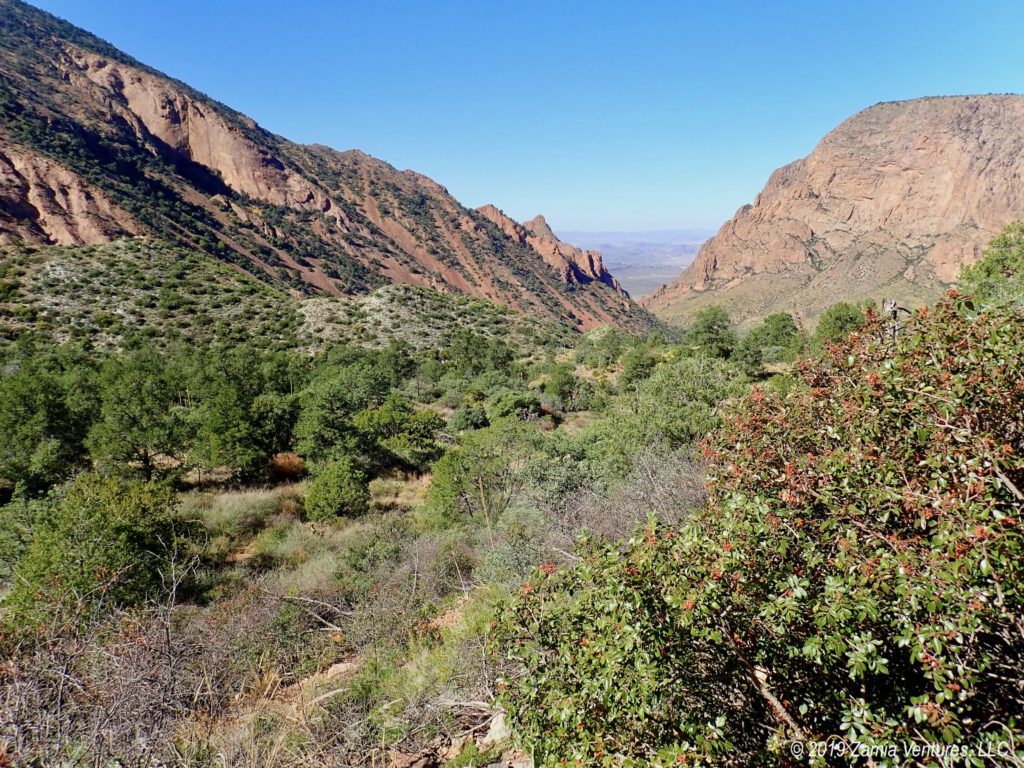
On our first stop in the Chisos Basin area we wandered through some of the shorter trails in the area like the Basin Loop and the Window View trail, enjoying hearing the constant birdsong and seeing desert dwellers like roadrunners alongside arboreal birds like the brilliantly colored Mexican jays and numerous small birds that were new to us, but too quick to photograph or identify. On our second visit to this part of the park we wanted to tackle the Lost Mine Trail, which came highly recommended by both the visitor center staff and fellow travelers. However, though we arrived at the trailhead at 9 a.m., the parking was already full. If only we had known that there was extra parking alongside the road, next to the “No parking on roadside” signs, as we saw when we left the area a few hours later. (Insert major eye-rolling here.)
In any case, we shifted gears and instead hiked the Window Trail, one of the most iconic in the park, which leads down from the lodge/visitor center/campground area to a narrow opening between two mountains through which all the rain that falls on the Chisos Basin runs off to the desert below. In a stroke of good luck, our timing on this trail was perfect. We saw only a handful of hikers on the way down, giving us plenty of quiet to enjoy the birdsong and views. We even ran into one of the local black bears, sitting not more than 15 feet off the side of the trail. Having an empty trail was particularly nice when it came to navigating the lowest area of the trail, which involves hopping over a stream multiple times and using some historic rock stairs installed by the CCC. By the time we made our way back up the trail from The Window we passed scores of hikers on the route, giving us an excuse to take a break and let them pass. Perfect!
Big Bend: Boquillas Area
As our main activity in the eastern section of the park we hiked from the Rio Grande Village area (which has campgrounds and a visitor center) to a hot spring situated on the banks of the river, about 3 miles each way. The first stretch of the hike brought us up a ridge with great views of the Rio Grande and the walls of the Boquillas Canyon. The middle section was just OK, featuring typical desert hiking with distant views of the Chisos Mountains, but the final section was outstanding. We loved seeing the rich riparian environment of the Rio Grande river bed from above and then from the level of the river. Once again, we saw numerous different birds that were completely new to us and also moving too fast to ID.
All three areas of the park offered different vistas and experiences. The park reminded us a bit of Death Valley, a park we visited in December 2018. Like Death Valley, Big Bend covers a very large area and has a very small window of time each year when temperatures are comfortable. In both places the distances and lack of available services mean visitors must strategically plan their visits to different far-flung sections of the park. And of course Big Bend is also a very dry place punctuated by islands of refuge within the desert created by springs and other natural water collection points. Our visit to Big Bend will be our last stop in a desert for a while, and it was a perfect way to cap off our long sojourn in the desert southwest.
Study Butte RV Park
We were visiting during one of the park’s busiest times of the year, the week of Thanksgiving, which we only discovered when we tried to book a campsite inside the park and found all the reservation sites to be completely full 5+ months in advance. Instead we ended up at Study Butte RV Park, a commercial park that’s just a stone’s throw from the western entrance to the park. It was an unusual spot for us because the place was basically half RV park and half junkyard. As Ken astutely observed, if this had been one of the first places we stayed on our journey, we probably would have driven back home immediately and sold the Airstream, abandoning the entire travel idea. On the other hand, this place does provide an answer to the age-old question: Is it possible to operate a hospitality business in the US in which 100% of the permanent structures (bathhouse, laundry facility, also storage sheds) are made from corrugated metal? Answer: apparently so.
Obviously our standards have eroded during our time traveling because we found it to be a convenient location to explore the park and enjoyed having the (corrugated metal) showers and laundry facilities. There is a terrific little general store right across the street selling a huge variety of high quality groceries and household/camping/automotive supplies at prices that were quite reasonable for this remote location. Rigs in the RV park are parked very close together but we enjoyed chatting with our neighbors, a young couple who work seasonal jobs doing trail building for the NPS at Glacier in the summer and here at Big Bend in the winter. Their dog Virgil was quite possibly the most mellow animal we have ever encountered. On the other hand, when they had a buddy over one evening the group sitting outside our door might as well have been inside our rig; we heard every last shred of the conversation. One thing I particularly loved was that the skies above our campground were inky black, making a perfect canvas for the stars to shine through. Walking out past the perimeter ring of junk allowed me to get some great shots of the surrounding mountains lit up by headlights of passing cars while blanketed by stars.
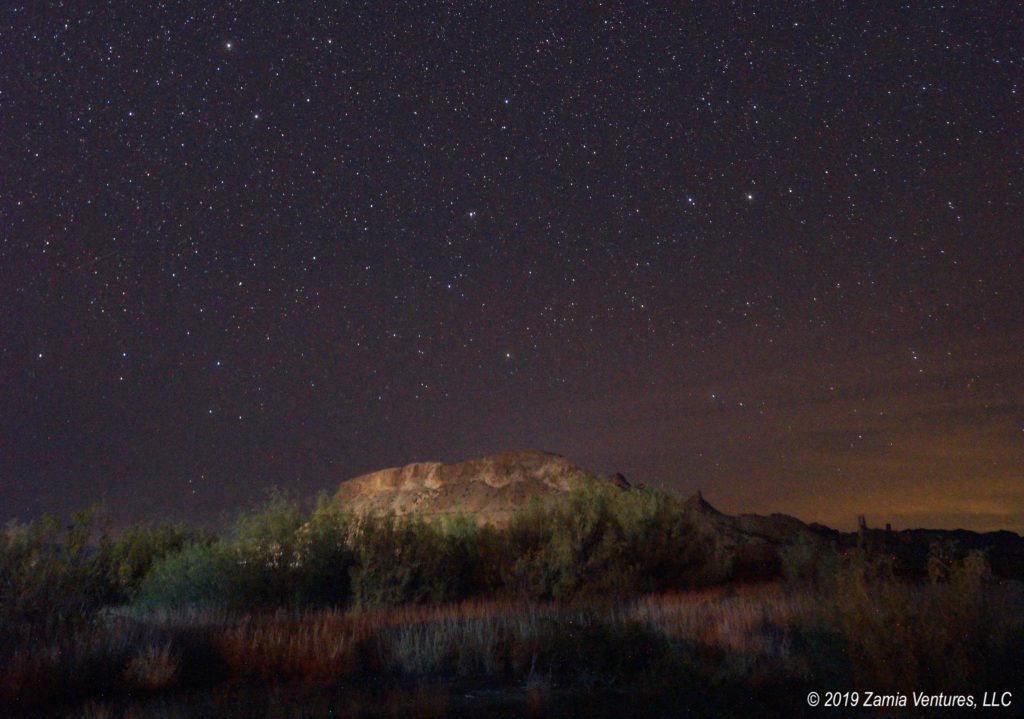
Terlingua Ghost Town
Our RV park was located fairly close to the town of Terlingua, a now-sort-of-abandoned town that was built to support the local industry of mining mercury (quicksilver). In the mid-1880s this place was a bustling company town with 2,000 residents, with lots of housing and a bevy of buildings that served the community like a church, theater, and general store. Today this is marketed as “Terlingua Ghost Town,” but I don’t think the people who came up with that marketing ploy understand that a ghost town is supposed to be populated by ghosts — that is, unoccupied by living humans. The former mining company store is now a store selling southwestern tchotchkes, the former “mansion” of the mine owner is now a small hotel, and the church remains in use for weddings and baptisms. The most interesting part of the old town was the cemetery, where the quality of the memorials tells the story of the town’s history. Many graves are just piles of rock topped by simple wooden crosses, but there are quite a few elaborate granite and metal memorials dating to the 1930s, clearly the heyday of this town. I noticed one Civil War veteran burial plot with the typical military headstone. He must have been wealthy and beloved, since his grave was surrounded by extremely rare and valuable wood pickets. There are more recent burials as well, and all the graves received some sort of beautification (candles, shiny beads, coins, empty beer bottles) for Day of the Dead celebrations a few weeks ago. The newest graves tend to feature homemade headstones and extremely eclectic grave decorations that a typical corporate cemetery would definitely frown upon.
Today the Study Butte-Terlingua area has about 250 residents, but is home to one of the top-rated restaurants in Texas. Perhaps not surprisingly, given the decidedly downscale nature of the community, this highly touted dining venue is basically a dude selling BBQ out of the window of a converted RV: DB’s Rustic Iron BBQ. Obviously we had to try it out. Ken enjoyed his brisket and I loved my pulled pork — both were juicy, a little smoky, and completely delicious. Sitting outside at the shaded picnic tables on a 75 degree day was pleasant. I can’t imagine what it’s like on a typical summer day.
Next: we tackle the 500-mile drive to Austin in two segments, with a one-night stopover along the way.

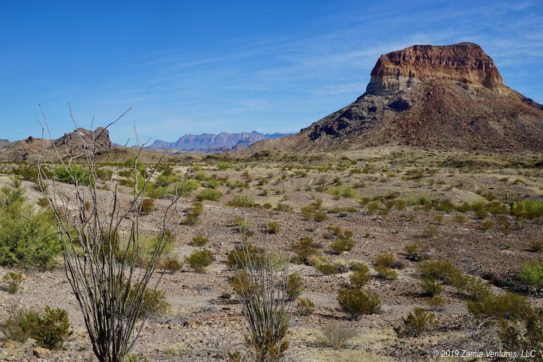
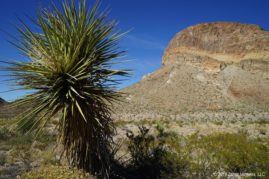
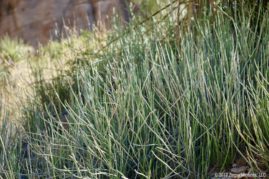
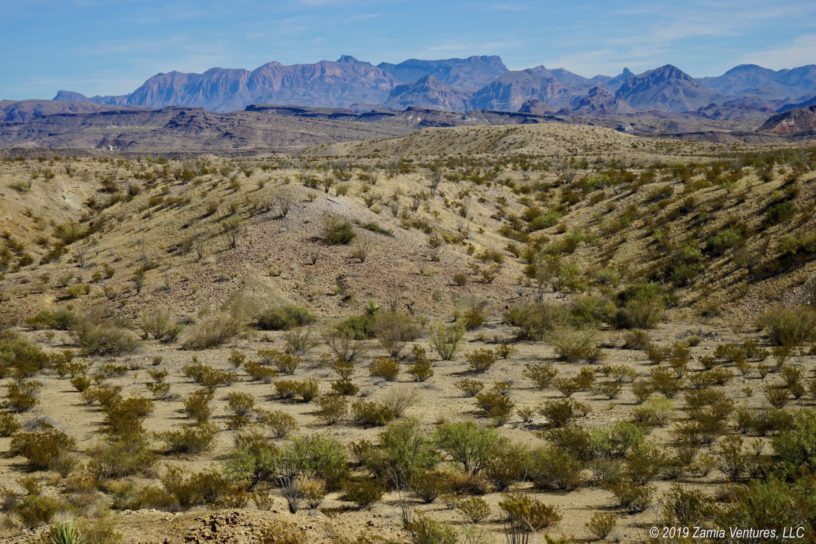
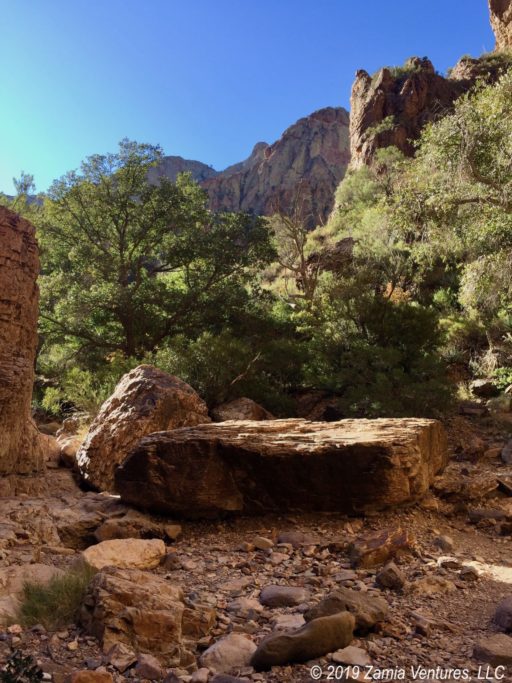

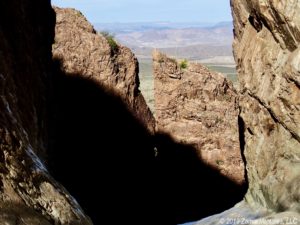
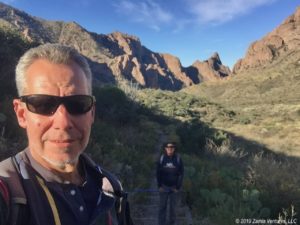
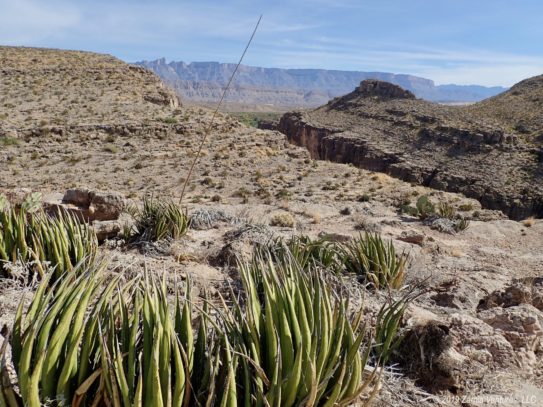
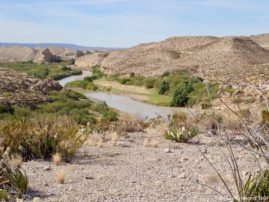
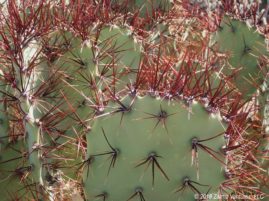
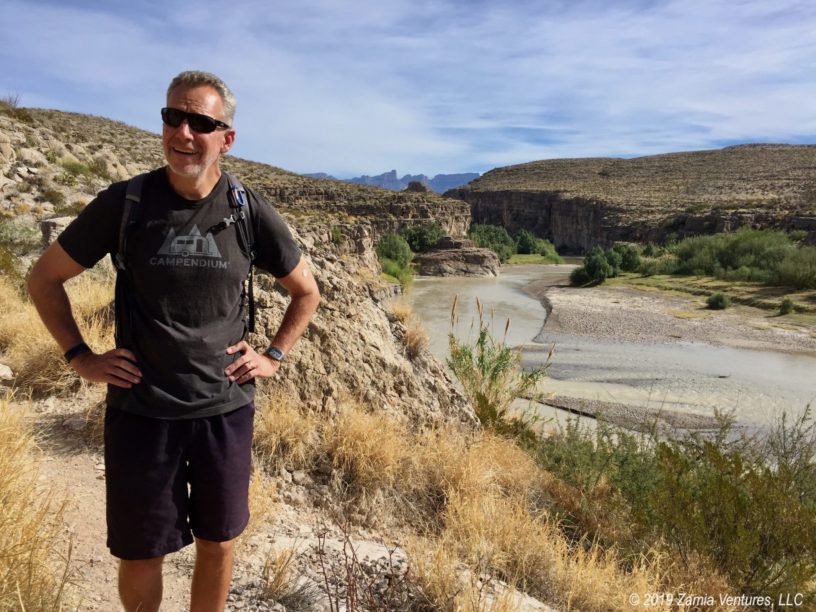
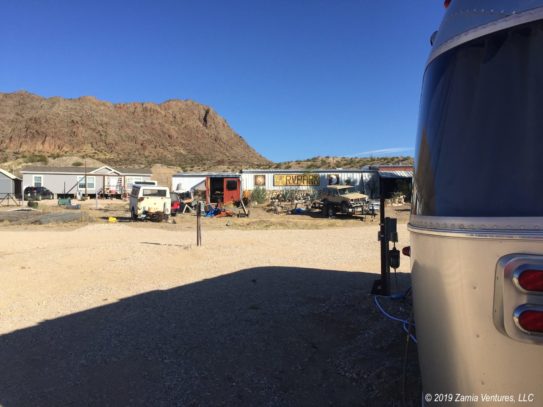
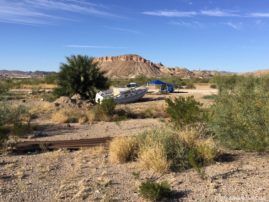
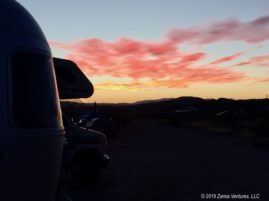
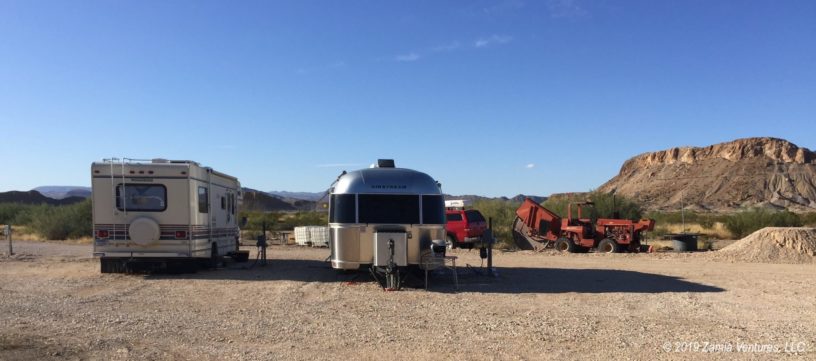
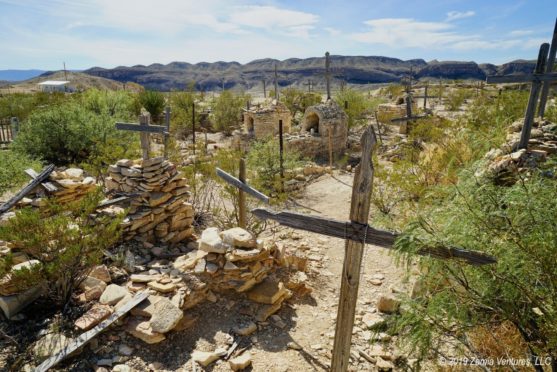
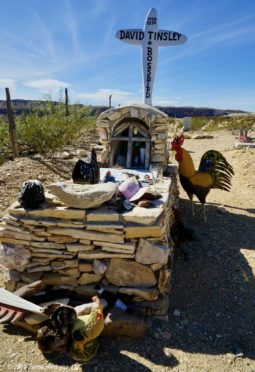
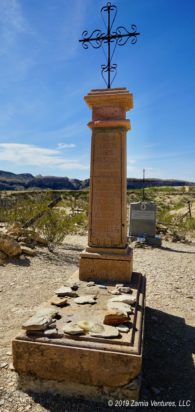
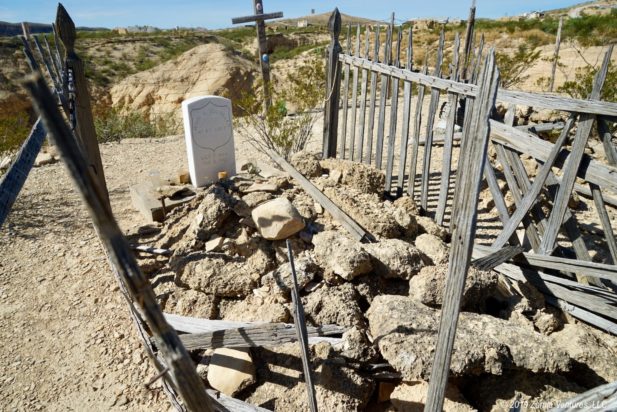
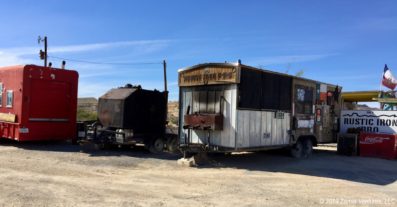
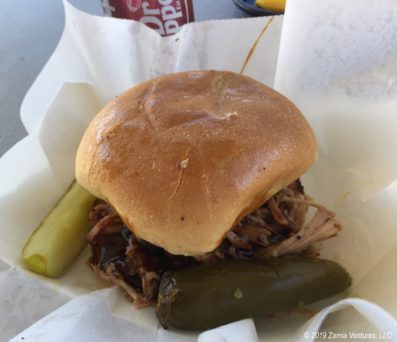
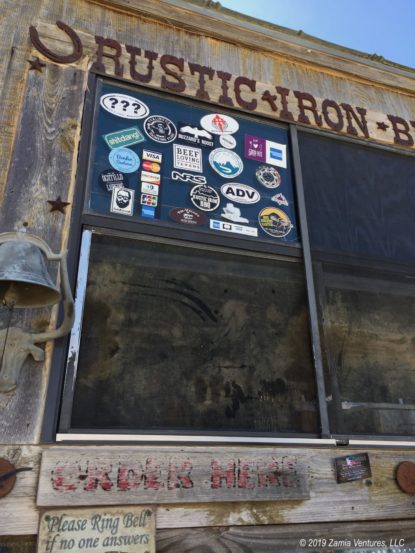
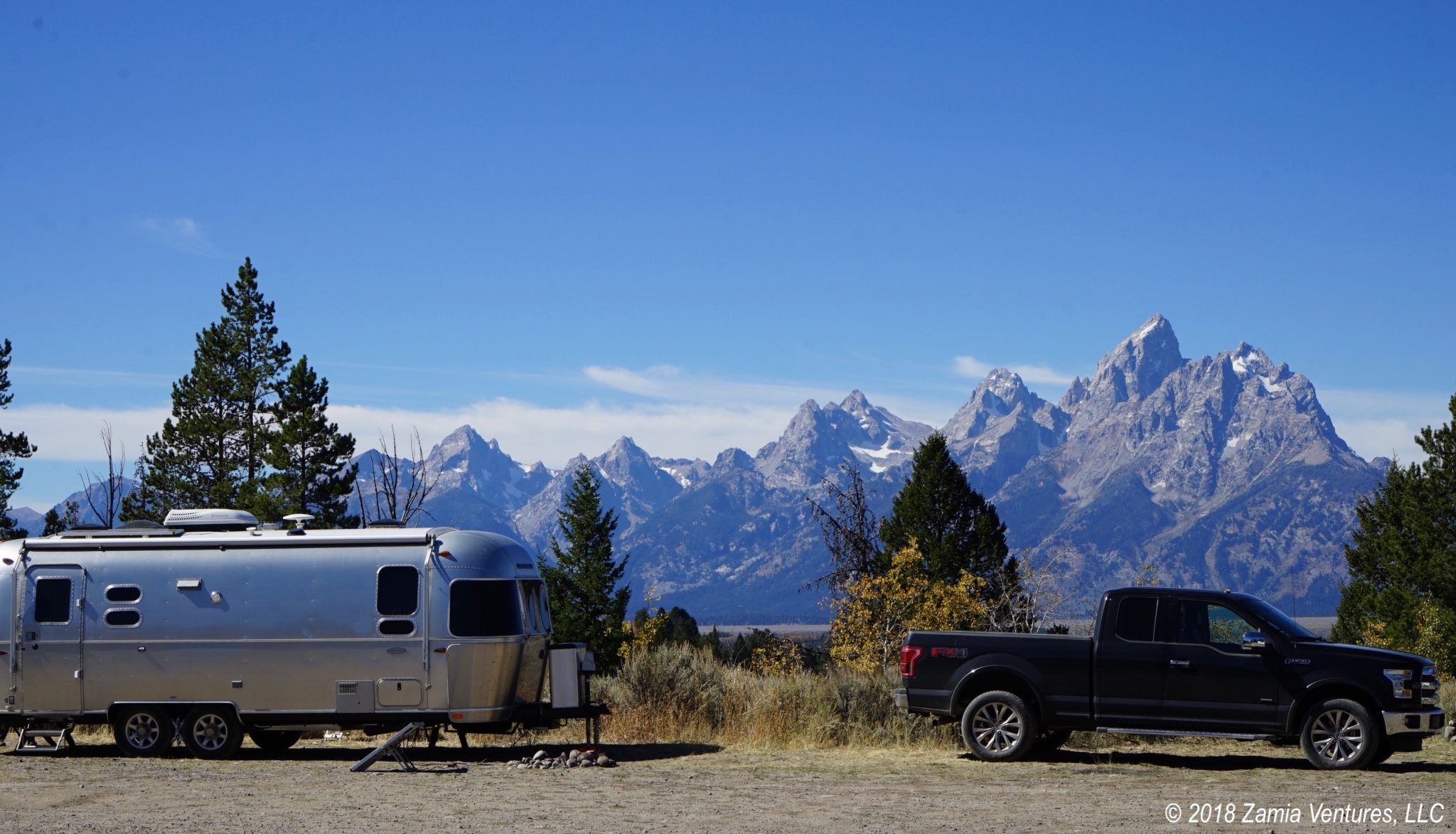
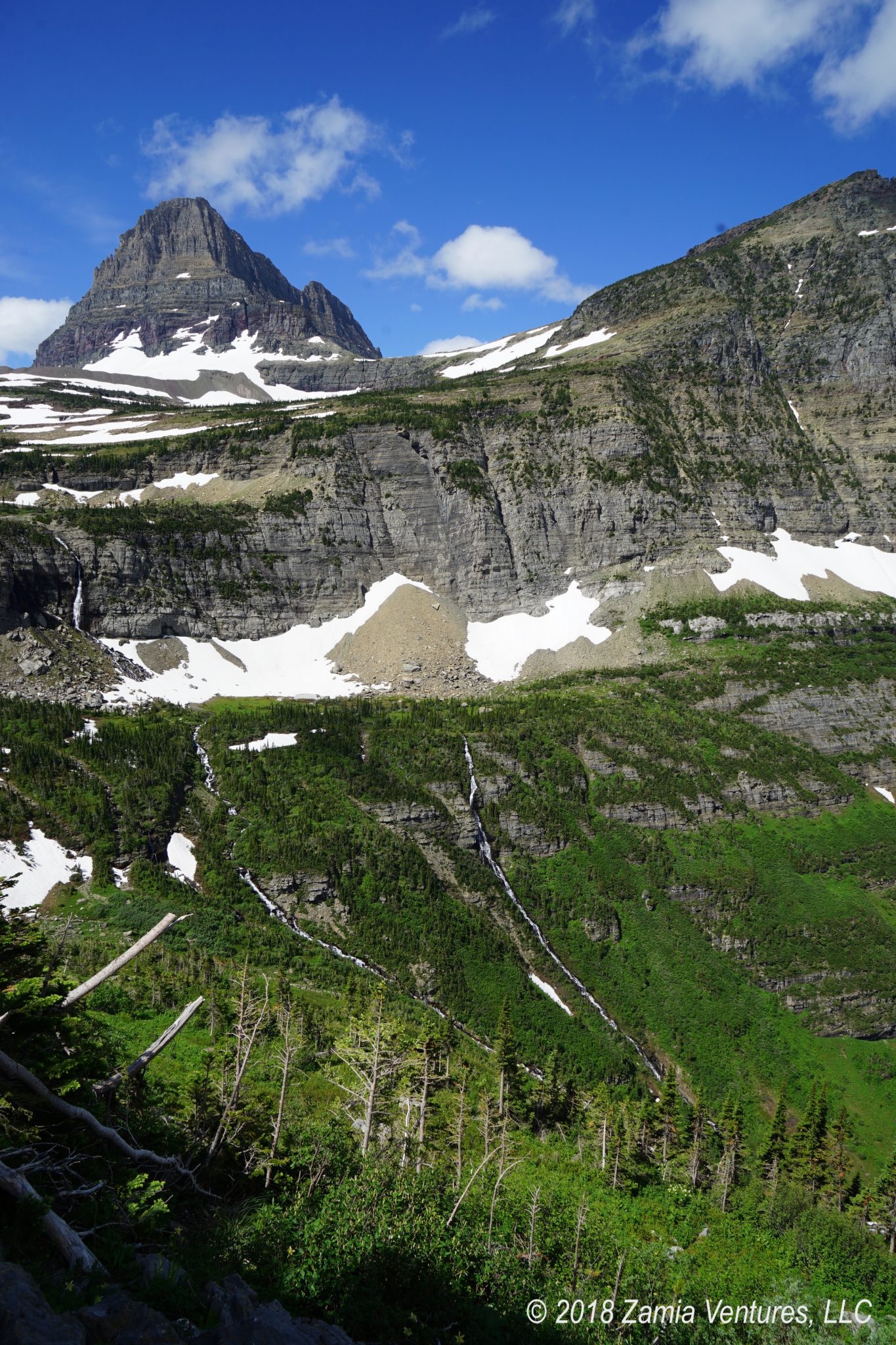
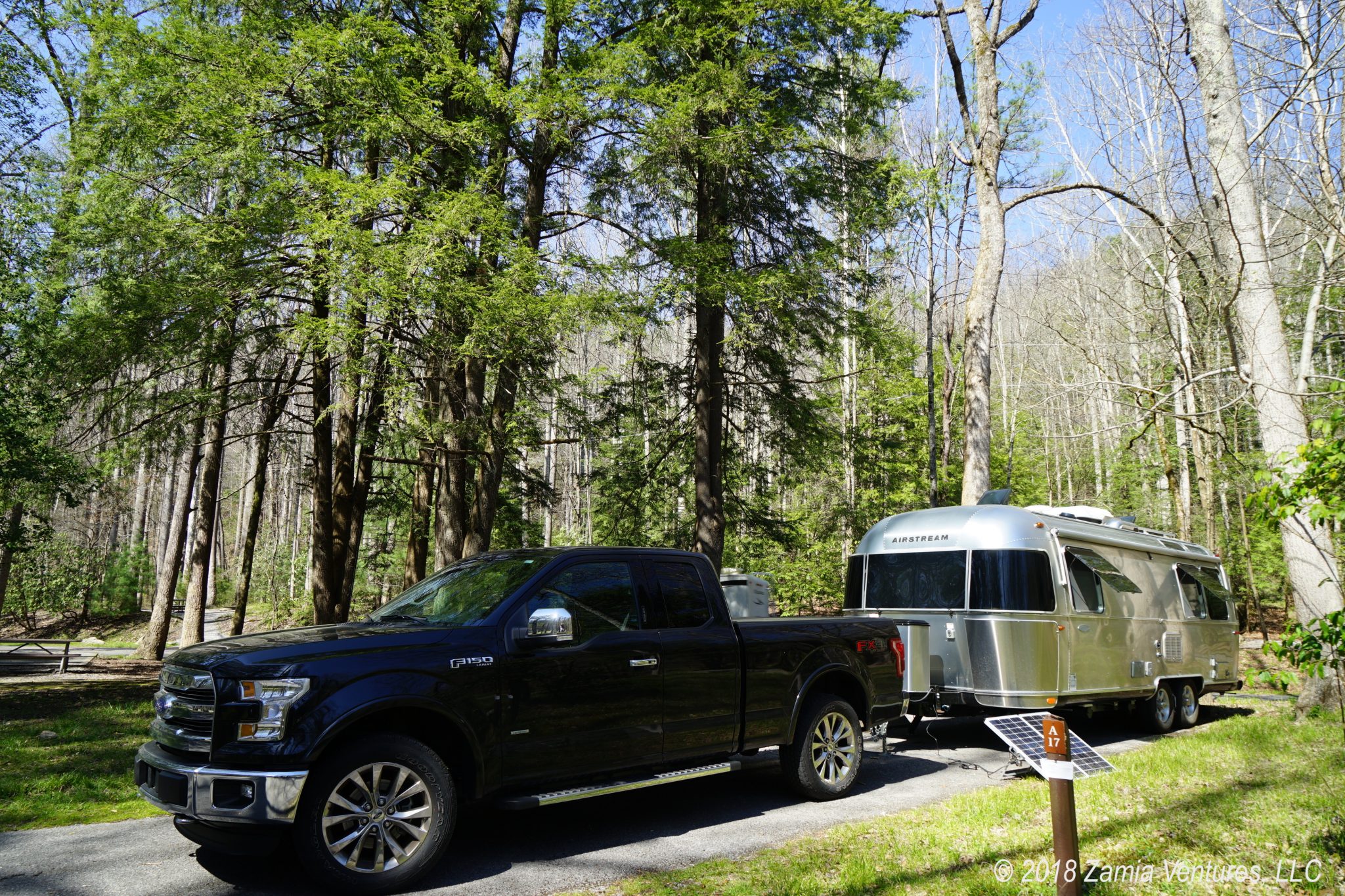
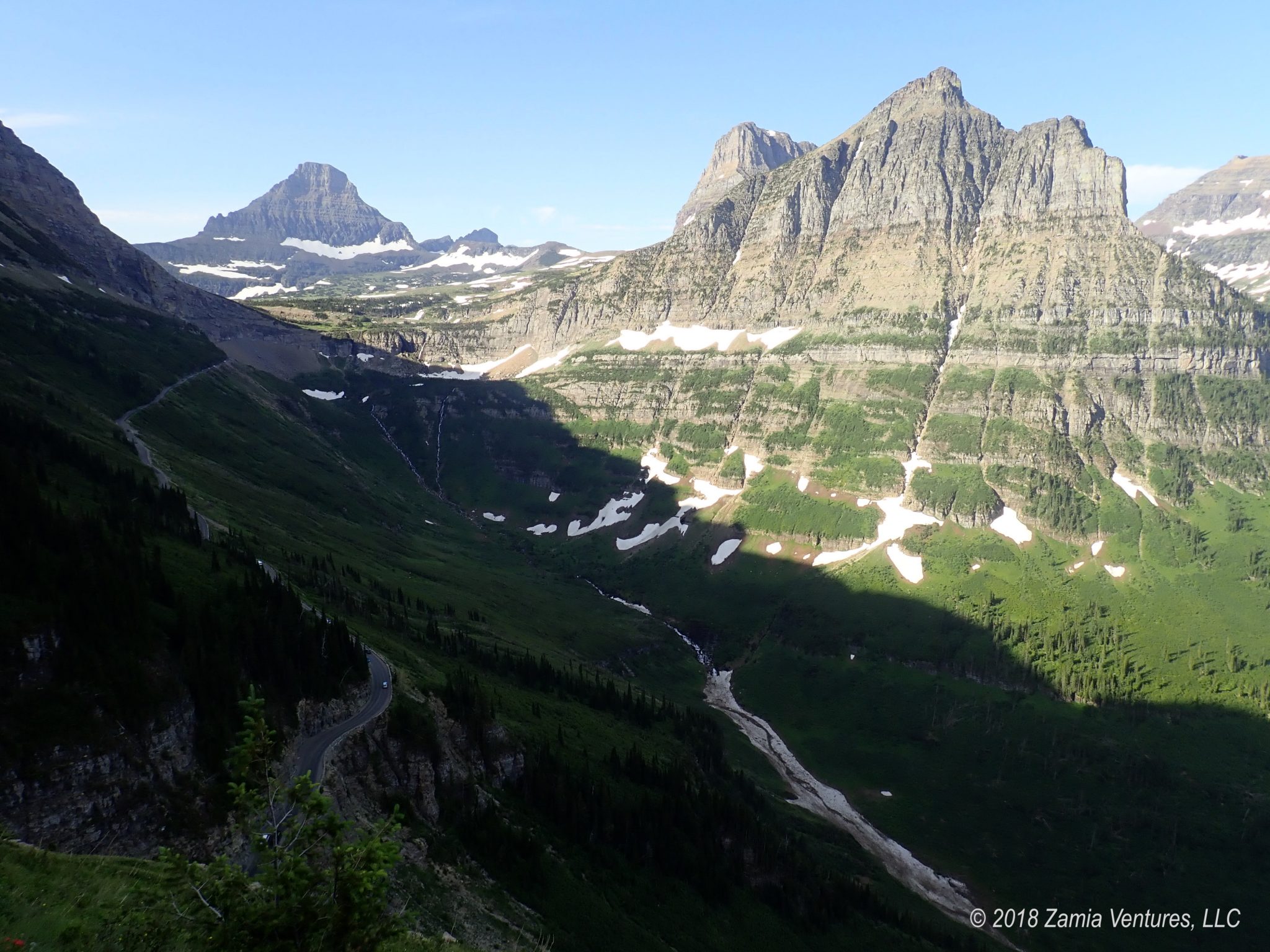
Oh, this brings back such good memories for us! We spent the week between Christmas and New Year’s in Big Bend NP a couple of years ago and had a fabulous time. It was so much more beautiful than I had imagined, and although it was COLD, I’ll take chilly temps over hot for hiking any day. How cool that you got to see a black bear!
We even stayed in the same RV park as you did…and yes, it was definitely half junkyard and half RV park. My initial thought when we arrived was, “Oh hell, what have I gotten us into?” But we loved it. Apparently, our standards have also ‘eroded,’ as you said. We also enjoyed the eccentric town of Terlingua. Sadly, the BBQ place was closed while we were there. Next time! Love your starry night photos.
Big Bend is yet another park where the NPS definitely did not steer us wrong! We had modest expectations coming in, since it’s in West Texas and all, but Ken actually compared it to Glacier, one of the most scenic parks we have visited — the rugged mountains rising dramatically from the desert are remarkable. All the different ecosystems, especially the lively areas along the river and in the Chisos Basin were fascinating. We also had pretty perfect temperatures, so I can see why the week of Thanksgiving is one of the most popular for visiting the park.
The RV park was a bit of a dump, but so was every other RV park we saw in the Terlingua area, and it felt completely safe despite its flaws. I guess travel has expanded our horizons because we would never have even stayed overnight there earlier in our journey!
We also found it befuddling that no one has made nicer RV/camping accomodations outside of the park. We stayed on the east side, also during Thanksgiving, but the description of your park sounds all too familiar.
Too bad you got skunked on parking for the Lost Mine trail. But you saw a bear! I think we’re the only ones who didn’t see one while we were there. Did you see tarantulas?
Great captures of the night sky! I guess if it were more nicely developed, the darkness would be ruined, so that’s a good thing, right?
A normal commercial RV park should make a killing here because people would be lining up to stay there, though I suppose the short visitation window makes it hard to earn a decent return on investment. I did find it bizarre that sites at our park were so close together, when there was SO MUCH empty land around us.
We actually had two encounters with the same bear, and it seemed extremely acclimated to hikers. We did see a tarantula crossing the park drive on our first day in the park, but we had driven past it by the time our brains processed what we had seen!
I agree that the lack of development in the area does help preserve the night skies, which is a nice asset. But why can’t we have a level campsite with a little room and ALSO dark skies? I want all the things.
Until recently, we were planning on visiting Big Bend this Spring, so I had done a bunch of research on it and was sure we would love it, but also feel very, very isolated. I did find a reasonably decent looking campground called Maverick Ranch. For better or worse though, it’s located to the west of the national park, right outside the gates of the state park. My understanding is the state park has similar geography, and would have been dog friendly, but it’s a bit of a trek from the national park. In any case, we’re not going this year, but your photos certainly ensure that it’ll remain on our list, and, while corrugated EVERYTHING sounds lovely, I think we’ll just deal with the longer drive. We’ve stayed in several of those “junkyard” type RV parks and if we can avoid them, we will. Come on, people. It’s just not that hard to get rid of junk!
BTW, your photo of the “walls” is a perfect example of why it’s sometimes so valuable to have people in a photo. If not for the people on the bottom right hand corner, I would not have appreciated just how huge those walls are. Great capture!
Finally, since you obviously appreciate good barbeque, and because everyone loves tacos, while in Austin, get yourself over to Valentina’s Tex Mex BBQ. If you don’t go, your entire trip will have been a waste. Trust me.
Big Bend was surprising in mostly good ways, and we loved the park. A nicer RV park would make the experience even better, and the extra drive to get into the park would make less difference to you since your toad is much more fuel efficient than our giant truck. So definitely keep it on your list for future travels. We’re very glad we made the stop despite the challenges.
Thanks for noticing the people in the canyon photo. I usually crop out the people but have recognized over time that many shots need something for scale, and by default it’s usually people. Goes against my typical misanthropic tendencies, but I suppose I have to make the sacrifice for “art.”
Thanks for the Austin tip. Once we finish eating our turkey leftovers, which will take DAYS, I know we will be desperate for some new flavors.